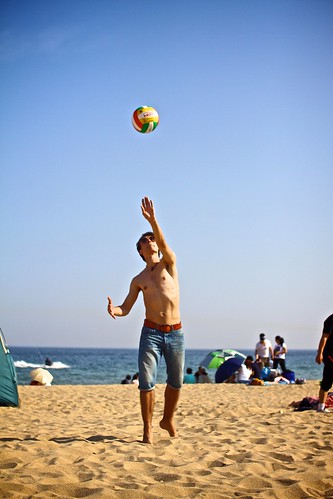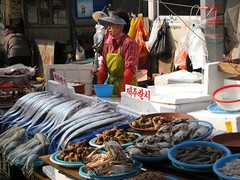A Weekend in Busan, South Korea

Strolling down the sidewalk along the busy road that passes in front of Busan Station, I squinted my eyes against the steady wind sweeping between the buildings.

Nampo-dong
Half a block landward from a busy street, the area known as “fashion street” stretches on for nearly a kilometer. Marked by new clean brick sidewalks, intermittent sculpture fountains and neatly kept flora, the outdoor mall felt much like any of the affluent shopping centers of suburban America. Here, the avid shopper will find the latest trends in fashion, upscale and local restaurants and markets showcasing independent artisans. An escalator leading up the hill shuttles tourists to the base of Yongdusan Park, a popular tourist attraction and event area topped by Busan Tower.
BIFF Square
At one end of the strip, you can find the home of the Busan International Film Festival. Known as BIFF Square, this area is packed with Korean culture and local eateries. When I was there, the line for tickets to the latest film at this small theater choked the wide walkway, and it wasn’t yet noon.
Jagalchi Fish Market
For those interested in seafood, a short walk toward the water will take you the Jagalchi fish market. This three-story building, elegantly designed in the shape of a swooping seagull hosts not only the full bottom floor lined with tanks of fish waiting to become the next delicacy, but two more floors of proper restaurants serving an array of seafood and other dishes.
The market overlooks the dry docks of Busan harbor. The occasional ship’s sounding of a ship’s whistle and incessant lapping of waves against the steel hulls of the ships creates a calming atmosphere only such port cities can offer.
Being a port city, the seafood is expectedly good. There are large fish markets like Jagalchi all around the city. My host led us to one of these a short walk from Gwangalli Beach.
These markets are not for the faint of heart. If you like your fish fresh, you can watch the whole process of swimming critters to bits of raw white meat. They are also quite local affairs, and it is advisable to find a translator or learn a few Korean phrases.
The particular woman from whom we purchased our fish was able to arrange for some condiments to accompany the fish (some garlic pepper sauce and sweet-and-sour sauce), but this is not standard service.
We carried our catch down to Gwangalli Beach, where hundreds of young Koreans had set out blankets or newspapers on the stone steps leading down to a stone shoreline. We picked a place near the waterline, and we had just enough time to finish our strips of raw fish before the tide overtook our space.
Food
Though the seafood is expectedly good, there are a few other treasures characteristic of Busan.
Bingsu
The first is the original bingsu (빙수). This sweet delicacy is made for friends. In a large bowl, baristas pile snow-like shaved ice, sweet gummy snacks, a few scoops of ice cream, and an array of frozen fruits. Though you can get bingsu just about anywhere in Korea these days, the treat originated in Busan.
Milmyeon
For those who enjoy the Korean tradition of cold noodle soup, Busan is known for a particular style called milmyeon (밀면). In a cold sweet and spicy broth, the chef lays a ball of rubbery wheat noodles. The noodles are a bit too chewy for my liking, but the dish is extremely popular among Koreans.
Dwaeji-guk-bap
One bowl I did enjoy was dwaeji-guk-bap (돼지국밥), a hot bowl of pork, noodle and vegetable soup. It made a fantastic breakfast on my first morning in the city. The soup is often served in a hot stone bowl, so don’t fear that it will get cold. Salt and other seasonings are usually provided on the table.
A little salt is advised, but most Koreans know the health risks of an excessively salty diet. They also may provide a shrimp sauce that adds a savory seafood taste to the dish. They will serve the soup with a small metal dish of rice (gongibap – 공기밥). I prefer to dump all the rice into the soup right away, but it’s your choice.
Hoddeok
By far my favorite delicacy from Busan was hoddeok (호뗙), a sweet fried rice pastry. With a light coating of sugar and optionally filled with a crushed peanut and sunflower seed mixture, these little guys are the perfect blend of sweet and salty fried goodness.
Especially in the area near the BIFF theater, you will find rows of food carts. An interesting trait about Korea is that people tend to assume that the most popular stand must be the best, so they stand in the longest line, feeding a perpetual cycle that leaves half the carts backed up and the others vacant.
No, they don’t know something you don’t. All the carts serve the same thing. Just pick the shortest line.
Beaches
While you are near the sea, those who crave unadulterated sunshine of the beach have a few famous options.
Gwangalli Beach (Open July 1 – Sept 10)
More popular with the locals, Gwangalli Beach offers a long strip of soft sand as well as the brick shoreline where we enjoyed our seafood dinner. While the beach is perfect for hanging out during the day, during the evening, the Gwangan bridge, which crosses the bay, sports thousands of lights and lasers.
At 8pm and 10 pm on weekdays and 8, 9 and 10 pm on weekends, a light show illuminates the structure, providing a gorgeous spectacle for those on the beach. On the main stretch of the beach, speakers play accompanying music for the show.
Haeundae Beach (Open June 1 – Sept 10)

The plan, however, had been misunderstood. The new zones were designed to provide for beach sports (volleyball, frisbee, soccer, etc.) instead of the rigid blocks of parasols where Koreans tend to hang out. There will be no enforced segregation.
Regardless, the beach tends to attract more foreigners and correspondingly hosts many western restaurants along storefronts that line the beach.
Songdo Beach (Open June 1 – Sept 10)
Less popular but equally beautiful is Songdo Beach. The oldest public beach in Korea (opened in 1913), Songdo Beach closed for a series of modernizing construction projects from 2000-2005.
If you see a whale in the water, don’t get too excited; it’s only a model. The beach now sports a kids area and allows access to an ocean trail that follows the mountainous shoreline.
Other ideas
These are only a small handful of the things to see and do in Busan. Not far from Nampo station, the Lotte department store rooftop provides a great view of the harbor and the surrounding area.
For sports fans, you can watch the Lotte Giants take one of their northerly rivals at Sajik Stadium just west of Seoul National University’s Busan campus. For those serious about shopping, the Shinsegae Centrum City, with nearly 294,000 square meters of floor space, currently holds the world record for the largest contiguous department store.




